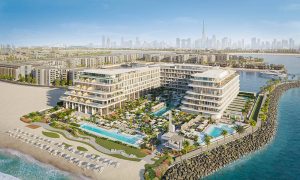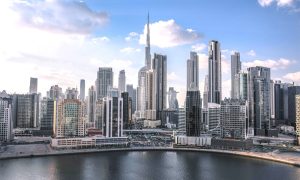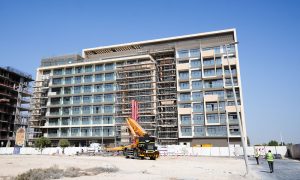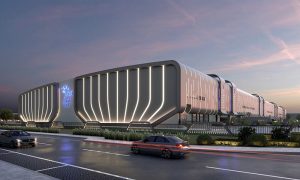Middle East’s mid-scale hotel sector gets a makeover
Hotels with lower room rates have seen greater traction than luxury properties

With a growing middle class and a younger guest profile, hoteliers across the Middle East are reorganising their market strategy. Starwood Hotels & Resorts, Hilton Worldwide and Premier Inn are just a few of the brands which have announced plans for mid-scale products, and more are likely to follow.
Governmental incentives are also fuelling investment in the mid-market segment in the run-up to Expo 2020. In January 2014, Sheikh Mohammed bin Rashid Al Maktoum, Vice President of the UAE and Ruler of Dubai, introduced a series of reforms to quicken the delivery of hotels.
These include cutting down the pre-approval process by two-thirds for private developers, an exemption from the 10% Dubai Municipality fee for three- and four-star hotels that begin operating by 2017, and allocation of government land for these hotels.
But besides these incentives, why have mid-market hotels seen greater traction than their luxury counterparts?
Salim Hussain at Brewer Smith Brewer Gulf, says it’s because tourists opt for mid-market hotels, keeping in mind that they want to spend money on experiencing the city. It’s also because the standards for mid-market hotels are a lot higher than in the rest of the world.
“Dubai is really expanding its reach and who it is targeting as guests. It has also got a very competitive and high level of luxury-market hotels when compared with the rest of the world, and I think the expectation is the same with the mid-market segment,” he says.
“Besides that, if you want to bring 20 million people here, then you’ve got to have a range of options and a range of opportunities to experience the city. Not everyone is going to want to stay in a five-star hotel, and given that people have the flexibility and the opportunity to do different things, different hospitality levels are essential.”
Rashid Aboobacker, associate director at Tri Consulting, agrees: “If you look at the macro picture, most corporate and even leisure travellers are on a budget and prefer to stay in mid-market and affordable hotels. Generally, the portion of travellers who are luxury and upscale oriented are much smaller than the budget and the mid-market ones, so clearly this segment is more in demand.”
Besides demand, healthy returns also have hoteliers catering to this segment. In terms of investment, lower capital requirements, a smaller construction period and smaller land requirements make them significantly more attractive. Meanwhile from an operational perspective, lean cost structure, higher profitability ratios and less revenue volatility make them sounder than a luxury product.
Elie Milky, senior director of Business Development at Rezidor Hotel Group, notes, “From an investment perspective, more owners are beginning to see the attractive model and offering of mid-market hotels in terms of development cost and operational efficiencies, plus the growing demand for more affordable branded accommodation across the Middle East is another reason to look at this segment.”
Aboobacker says that mid-market hotels are also considered recession-proof compared to five-star hotels because they can adapt in tough market conditions, giving owners the upper hand.
He also points out the advantage from a customer perspective. “If you look at the traditional mid-market hotels here, a lot of them offer most of the services that you get in a five-star hotel. The room sizes in a mid-market hotel are typically larger compared to the European market, at around 28 to 32 square metres. They have multiple food and beverage outlets, some have large conference facilities and 24-hour room service, so most of them are actually full service hotels. For customers, it’s really good, because they get all of these facilities at more affordable rates.”
Another advantage that mid-market hotels have over luxury hotels is that they are seen as more “hip, cool, fashionable and design-oriented” to a younger guest profile, notes Hussain. It also caters to them because they aren’t looking at spending much time in the hotel room anyway.
“You have people who are here for only a few days and they want to stay in a place which is convenient, clean, has nice facilities and good food, but they obviously will not be spending the entire day there. Those people don’t necessarily need a five-star banquet hotel, because they’re going to spend 90% of their time outdoors.
“On the other hand, if you’re in a resort, you’re going to stay there because that’s why you’re going there in the first place. You have a family and everyone is there to enjoy the waterworks, entertainment, food and everything else offered, so you aren’t looking to leave that place.”
With Dubai’s Department of Tourism and Commerce Marketing expecting 20,000 to 35,000 new hotel keys to be added by Expo 2020, hoteliers should also look at adding better lifestyle products to make them more attractive without increasing budgets.
Aboobacker says, “At a higher level, most of the lifestyle brands are targeting a younger audience who are technology oriented, and one of the good differentiators in mid-market hotels is the greater use of technology. You can check in online, open your hotel room on your mobile or iPad, maybe even book a table at a restaurant, and this is a big differentiating factor.”
“Another factor is the unique designs. There’s a lot more emphasis on colours and themes, unique room types and F&B outlets, which goes well with the younger crowd. Hotel operators also create social spaces in these hotels where there is greater opportunity for travellers to meet, rather than the old-style lobby where there is a huge distance between each table.
“One more thing that could happen in the Middle East are themed hotels like art hotels. For example, Paramount is a brand that has done that in the past, and MGM is another that has created hotels themed around movies, film stars and sports.”
“I think such opportunities are numerous, and we will be seeing a lot more of these unique products coming into the market in the future.”
Hussain says that as a consultant, it’s a matter of using existing facilities smartly and making better use of the opportunities a hotel has to offer.
“If you have a pool, then what we’re going to do is make that an infinity pool that looks towards a view, so it’s not just something you stick on top of a roof. These are standard things that you require for a hotel, but the idea is to make them a destination in their own right, make them a special experience. The pool then is not just some box but becomes a major feature of the hotel.
“Another thing that should be considered is if it can become part of a bigger complex, like for example as part of a mall or a wider development, and if it can offer a kind of shopping point. Even the resort experience is being expanded, where you have a huge mall next to the hotel, so in a way the guests never need to leave the vicinity.”
Milky points out that comfort and lifestyle, rather than luxury, should be associated with mid-market hotels. “What should be included are basic needs of the customer, ranging from a comfortable bed, a good room design, clean, fresh and modern interiors, healthy food choices and streamlined connectivity. We are proud to offer these in our fresh, mid-scale Park Inn and in our lifestyle select Radisson Red Hotel brands.”
These kind of design and lifestyle additions brings up the question of affordability, and considering cost is a huge driver of this segment, it has to be kept in check for the developer, operator and customer. But Milky, Hussain and Aboobacker feel that cost will barely be affected.
“I think it won’t have much impact on the cost of development, except for a couple of factors, such as the design. I’m not sure, but the range for design costs may be 20-25% more as compared with a traditional hotel,” says Aboobacker.
“There are though some designs that I have seen in lifestyle hotels that might save on costs for owners, because they use space more wisely. But as these hotels become more mainstream, and you have more designers doing this sort of work, the cost should come down.”
Hussain agrees, saying it all lies in the skill of the architect working on the project.
“I don’t think it should have any impact on the cost of development, because that’s where the architect has got to bring their added value, and that’s what we bring to the table. It is about how you do more with less, to ensure new designs meet the expectations of owners and users.
“The client is not going to start increasing budgets because the reason they are building a mid-market hotel in the first place is so that the cost is less and the running costs are lower, so by the same reasoning the input is going to be less. It is going to be a question of how you can do things with what you’ve been given, thinking cleverly about the kind of building material that you use, and so on and so forth.”
With so many mid-scale hotels flooding the market in the run-up to Expo 2020, the obvious concern is that there may be an over-supply after the event, but the trio say there’s nothing to worry about.
“This type of product would survive the aftermath much better than the luxury segment, and this is because of the affordable nature of such hotels. The low developmental cost and low operational costs associated with such an operation makes it a less risky hotel real estate investment compared to upper scale and luxury hotels,” says Milky.
Hussain adds that the idea of having 20 million visitors per year will not stop at 2020. “Expo 2020 is a milestone, but I don’t think that it is the end of the journey, and we have to look beyond that. For me, it is about how you bring people to Dubai, almost irrespective of what the event is. If it’s not Expo 2020 that’s bringing them here, there will be some other enticement.”
“You’ve got a lot of big things like Legoland, Bollywood theme parks and other things like conferences and exhibitions going on. So there are other things in Dubai that will continue to happen and bring people here.”
Aboobacker says, “I feel the next asset class that will see growth is budget hotels and home-stay, which is catching up.”
Hussain concludes by saying, “It would be interesting to see smaller, boutique hotels opening up. These boutique hotels could be owner-operator enterprises that allow people to give their unique take on Middle Eastern hospitality.”

























